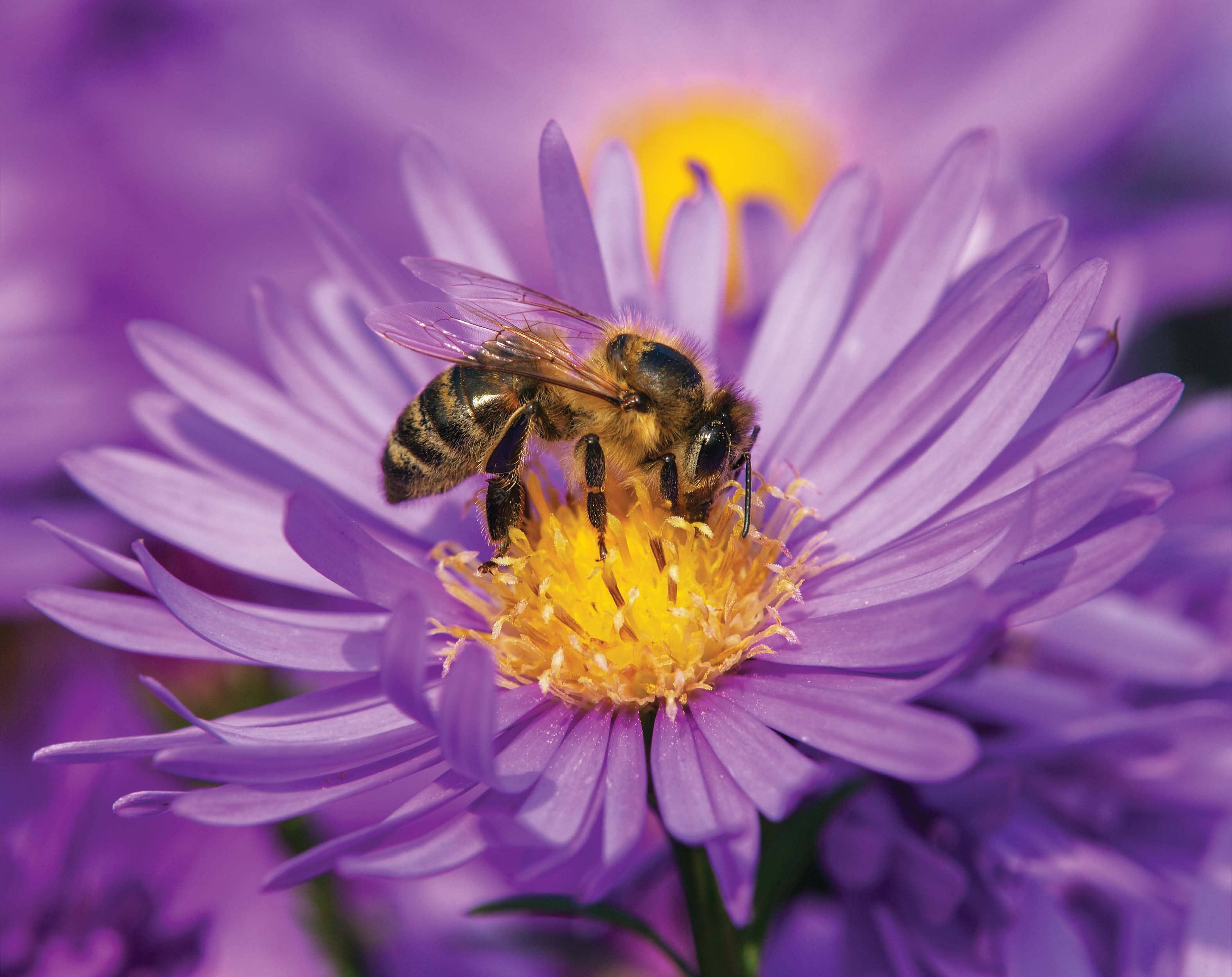
detail of bee or honeybee in Latin Apis Mellifera, european or western honey bee sitting on the yellow violet purple or blue flower
Bee-Friendly Gardens
Honeybees are critical to life on the planet. In fact, 70 of the top 100 food crops worldwide are pollinated by bees, and these mighty insects take care of about 80% of pollination worldwide. A huge portion of the country’s food supply—fruits, vegetables and almonds—is possible because of these pollinators. Here are two easy ways to help bees:
Plant bee-friendly flowers. Fill your garden with a diverse group of plants, especially with those native to where you live, that can offer bees what they need: pollen and water. The best flowers for bees are single-flower tops such as marigolds and daisies, as these give bees easy access to pollen.
Help bees hydrate. As all species, bees need water to stay alive. In your garden or on a balcony, leave a small saucer or birdbath filled with water and be sure to include some rocks or objects for them to perch on while they quench their thirst. And don’t add any sugar in the water—they get plenty of sweetness from the nectar they consume.
The Honey Bee
Did you know that the honey bee is the only insect that produces food eaten by humans? Honey bees, scientifically known as Apis Mellifera, are environmentally-friendly and are vital as pollinators. A honey bee can fly for up to six miles, and as fast as 15 mph. So it would have to fly around 90,000 miles—three times around the globe—to make one pound of honey. And it only takes one ounce of honey to fuel a bee’s flight around the world. Honey is 80% sugar and 20% water. And honey bees produce beeswax from eight-paired glands on the underside of their abdomens. Here are some other fun facts about the queen bee and worker honey bees:
The queen bee lives for about two to three years. She is the busiest in the summer months, when the hive needs to be at its maximum strength, and lays up to 2,500 eggs a day. The queen may mate with up to 17 drones over a one- to two-day period of mating. She is constantly fed and groomed by attendant worker bees.
Worker honey bees live for about four weeks in the summer, but up to six months in the winter. A honey bee visits 50 to 100 flowers during a collection trip, and the average honey bee will make only one-twelfth of a teaspoon of honey in its lifetime.
Pesticide-free Gardening
Planting a home garden is a great hobby that encourages gardeners to eat more fruits and vegetables. It’s also a therapeutic activity that reduces stress. One of the greatest challenges, however, is deterring pests such as bugs and rodents. Rather than resorting to harmful pesticides to keep them away, there are plenty of natural and sustainable methods to protecting plants from the following hungry critters. Here are some tips.
Aphids are common in most gardens. These tiny bugs feed by sucking the nutrient-rich liquids out of plants. In large numbers, they can do quite a bit of damage. To deter them, plant chives, marigolds, mint, basil or cilantro in your garden. You can also purchase ladybugs at select local gardening stores and release them in your garden. Ladybugs can devour up to 50 aphids a day.
Slugs and snails are notorious garden-dwellers. In fact, the average garden contains more than 15,000 slugs! You can trap and relocate slugs and snails by laying boards or pieces of cardboard on the soil around your plants overnight. In the morning, you’ll find some sticking to the underside and can transport them from the garden. You can also plant their favorite plants, such as chervil, marigold and thyme, to keep them away from your other vegetables. You can also find ways to attract natural predators such as songbirds.
Mice are bothersome and can contaminate your crops. To keep them out of your garden, try planting mint plants. Mice especially dislike peppermint and they will avoid areas where it is grown. Other plants that may ward them off include pennyroyal, garlic and onion.
Rabbits have a voracious appetite and will chew up all kinds of fresh vegetation. To keep them away, use chicken wire as a barrier, or lace the perimeter of your garden with hair from your hairbrush. (Rabbits don’t like the texture or scent of human hair.) Planting onions may also keep them away. You can also sprinkle chili pepper or talcum powder on your plants. Be sure to reapply when it gets wet.



